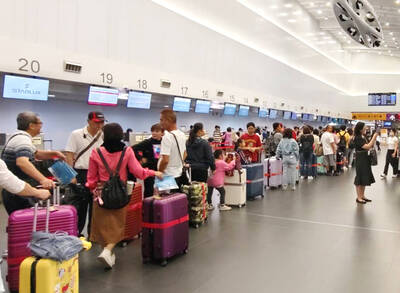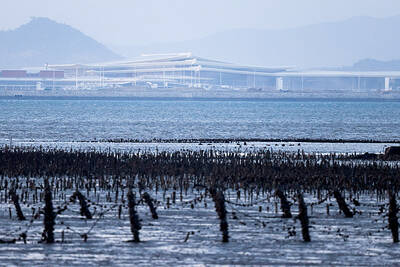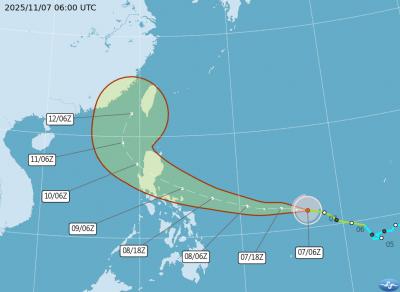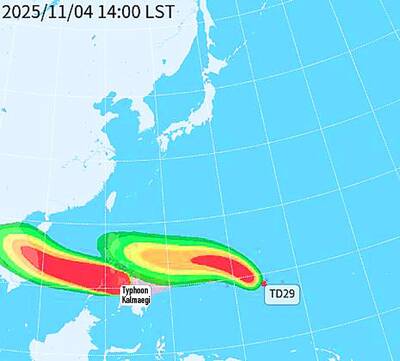As the amount of business waste is overtaking incinerator capacity, the Environmental Protection Administration (EPA) is promoting turning business refuse into solid recovered fuel (SRF).
Turning waste into energy can resolve waste disposal challenges and reduce fossil fuel use, EPA Deputy Minister Shen Chih-hsiu (沈志修) said on Friday.
Twenty-six percent of all waste incinerated last year came from commercial and industrial sources, Shen said, citing EPA data.
The power generation efficiency of incinerating regular waste is about 20 percent, but it can be increased to 30 percent via treatment, he added.
SRF is created from combustible components of waste, including plastics, biodegradable material, paper and metal.
It has a low environmental impact and low cost, and can be used as a substitute fuel in high-efficiency boilers and combustion facilities, emitting far less carbon than coal, Shen said.
Using SRF in industrial burners could lighten the load on incinerators, he added.
“At the moment, there is not enough capacity to handle household waste,” Shen said. “Hopefully, high-caloric refuse will not be incinerated, increasing capacity for household waste.”
About 2 million tonnes of business waste is incinerated every year, 700,000 tonnes of which can be turned into SRF, Department of Waste Management Director-General Lai Ying-ying (賴瑩瑩) said.
The EPA and the Ministry of Economic Affairs would work together to develop the field, Lai added.
Ling Yung-sheng (凌韻生), director of the Industrial Development Bureau’s Sustainable Development Division, said that the manufacturing sector produces more than 17 million tonnes of waste every year.
Through experimentation, testing and help from the EPA in establishing regulations, refuse can be transformed from a burden into an energy source, he said.
It could also form a new industrial supply chain, generating more economic benefits, he added.
“Waste is a misplaced resource,” Industrial Technology Research Institute green energy division deputy director Wan Hao-peng (萬皓鵬) said. “If it can be transformed into energy, new industrial applications could be developed.”
The institute has been researching SRF since 2001, Wan said, estimating that the nation is capable of transforming about 2.7 million tonnes of business waste into about 370 megawatts of energy, enough to power nearly 600,000 homes.
The paper, fabric and cement industries are contributing the most to SRF production, Shen said, expressing the hope that more industries would join in.
The EPA estimated that next year, 390,000 tonnes of waste would be transformed into fuel, increasing to 470,000 tonnes by 2023.

Three Taiwanese airlines have prohibited passengers from packing Bluetooth earbuds and their charger cases in checked luggage. EVA Air and Uni Air said that Bluetooth earbuds and charger cases are categorized as portable electronic devices, which should be switched off if they are placed in checked luggage based on international aviation safety regulations. They must not be in standby or sleep mode. However, as charging would continue when earbuds are placed in the charger cases, which would contravene international aviation regulations, their cases must be carried as hand luggage, they said. Tigerair Taiwan said that earbud charger cases are equipped

UNILATERAL MOVES: Officials have raised concerns that Beijing could try to exert economic control over Kinmen in a key development plan next year The Civil Aviation Administration (CAA) yesterday said that China has so far failed to provide any information about a new airport expected to open next year that is less than 10km from a Taiwanese airport, raising flight safety concerns. Xiamen Xiangan International Airport is only about 3km at its closest point from the islands in Kinmen County — the scene of on-off fighting during the Cold War — and construction work can be seen and heard clearly from the Taiwan side. In a written statement sent to Reuters, the CAA said that airports close to each other need detailed advanced

Tropical Storm Fung-Wong would likely strengthen into a typhoon later today as it continues moving westward across the Pacific before heading in Taiwan’s direction next week, the Central Weather Administration (CWA) said. As of 8am, Fung-Wong was about 2,190km east-southeast of Cape Oluanpi (鵝鑾鼻), Taiwan’s southernmost point, moving westward at 25kph and possibly accelerating to 31kph, CWA data showed. The tropical storm is currently over waters east of the Philippines and still far from Taiwan, CWA forecaster Tseng Chao-cheng (曾昭誠) said, adding that it could likely strengthen into a typhoon later in the day. It is forecast to reach the South China Sea

WEATHER Typhoon forming: CWA A tropical depression is expected to form into a typhoon as early as today, the Central Weather Administration (CWA) said yesterday, adding that the storm’s path remains uncertain. Before the weekend, it would move toward the Philippines, the agency said. Some time around Monday next week, it might reach a turning point, either veering north toward waters east of Taiwan or continuing westward across the Philippines, the CWA said. Meanwhile, the eye of Typhoon Kalmaegi was 1,310km south-southeast of Oluanpi (鵝鑾鼻), Taiwan’s southernmost point, as of 2am yesterday, it said. The storm is forecast to move through central